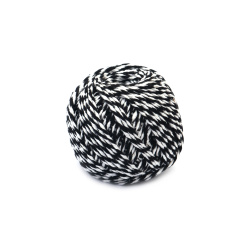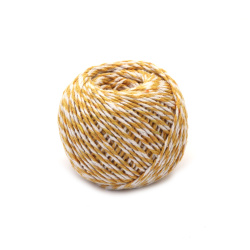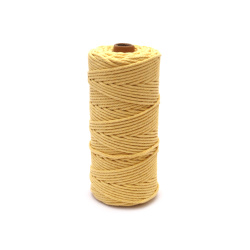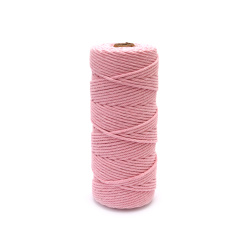Waxed Cotton Cords thickness from 1mm to 3mm
Waxed cotton cords/strings are available in a wide range of beautiful colors. Round ones predominate, but we also offer flat ones. Some of them are spiked, while others have a wax coating that protects them from wear and discoloration. The cotton cord is a pleasing, breathable, natural material with great strength and can be used to create jewelry, accessories and interior decorations. It is suitable for techniques such as macrame, kumihimo, or loose interpretations of one’s own imagination in combination with beads. Use auxiliary materials such as fasteners, tips, and
View more
Twisted Cotton Cord 1.5 mm, Black and White - 50 grams

Twisted Cotton Cord / 1.5 mm / Yellow Color - 50 grams

Twisted Cotton Cord / 1.5 mm / Ash of Roses Color - 50 grams

Twisted Cotton Cord 1.5 mm, Blue - 50 grams

Twisted Cotton Cord 1.5 mm, White and Light Pink - 50 grams

Twisted Cotton Cord 1.5 mm, White and Green - 50 grams

Twisted Cotton Cord 1.5 mm, White and Dark Pink - 50 grams

Twisted Cotton Cord 1.5 mm, Dark Pink - 50 grams

Twisted Cotton Cord / 1.5 mm / White and Orange - 50 grams

Twisted Cotton Cord / 1.5 mm / Orange Color - 50 grams

Twisted Cotton Cord / 1.5 mm / Light Green Color - 50 grams

Twisted Cotton Cord / 1.5 mm / Red Color - 50 grams

Twisted Cotton Cord / 1.5 mm / White and Yellow - 50 grams

Twisted Cotton Cord 1.5 mm, Ecru -50 grams

Twisted Cotton Cord 1.5 mm, White - 50 grams

Twisted Cotton Cord / 1.5 mm / White and Blue - 50 grams

Cotton Cord for DIY and Crafts / 4 mm / Color: Ecru - 100 meters

Natural Cotton Cord for Macrame, Home Decor etc. / 6 mm / Color: Ecru - 50 meters

Natural Cotton Cord for DIY Home Decor and Crafts / 5 mm / Ecru Color - 50 meters

Cotton Cord, 3mm, White Color - 1kg ~400 Meters

Cotton Cord for DIY Accessories / 3 mm / Red - 500 grams ~ 135 meters

Cotton Cord / 4 mm / Color: Black - 100 meters

Cotton Cord / 3 mm / Color: Light Yellow - 100 meters

Cotton Cord / 3 mm / Color: Light Blue - 100 meters

Cotton Cord / 4 mm / Color: Green - 100 meters

Cotton Cord / 1.5 mm / Color: Ecru ~ 480 meters

Cotton Cord / 3 mm / Color: Rose Ash - 100 meters

Cotton Cord / 3 mm / Color: Light Green - 100 meters

Cotton Cord / 1.5 mm / Color: Ecru - 180 meters

Cotton Cord / 3 mm / Color: Red - 100 meters

Cotton Cord / 3 mm / Color: Black - 100 meters

Cotton Cord / 3 mm / Color: Light Pink - 100 meters

Cotton Cord / 4 mm / Color: Orange - 100 meters

Cotton Cord for Decoration / Size: 3 mm, 100 meters, Color: Ecru

Cotton Cord for Decoration / 2 mm, 100 meters

Cotton Cord for Decoration / 1.5 mm, 100 meters

Cotton cord 2.2 mm pressed white, red and green 3x4 kata ~ 20 meters

Cotton cord 2 mm pressed white and red 2x4 kata ~ 40 meters

Cotton cord 1.5 mm white with gold color lame ~ 20 meters

Cotton cord 1.5 mm white with silver llama ± 20 meters

Jewellery cotton cord 3 mm
Videos in the channel of EM ART
How to make a baby clip with materials from EMART?
Make natural materials an original gift for your kids. This wonderful accessory will create comfort for you and your child. Made of natural materials from EMART It is extremely safe, while and original.
Cotton Cords in Various Color Ranges
Cotton cords are a great alternative to leather straps. Coated with wax, making them resistant to water and abrasion, they can be used to create necklaces, pendants, bracelets, and many home decorations. They are also suitable for gift wrapping and tying tags. Combining several colors of cotton cords can be an excellent choice for macramé. The cotton cord from EM ART is a pleasant, breathable, natural material with great strength. We will present you with some ideas on how you can use our cotton cords and enjoy a wonderful result achieved mainly from your imagination.
Ideas from EM ART
Macramé
This weaving technique has been known for centuries and is believed to have been brought to Europe in the 9th century from the East. Today, many people consider this type of handicraft typical for older women in the family. However, using the macramé technique you can create things far beyond a tablecloth or a bed panel.
Macramé is a type of handicraft where the knot connects two threads and has a decorative role. Make various decorations by arranging threads and securing them through knots.
Here’s what you need to learn to practice macramé knots:
- Macramé: This can be a twine, cotton cord, or synthetic.
- Support: You’ll need something to tie your knots to. Popular options include dowels, branches, hoops, and rings.
- Scissors
The first knot you need to know is the lark’s head knot, sometimes called a cow hitch. This knot attaches the macramé cords to an object, such as a dowel, branch, or anchor. Fold your cord in half and place the loop over the stick of the dowel. Bring the loop around the back and pull both ends of the cord through the loop to tighten it. The reverse lark’s head knot is made on the opposite side, so the bump is hidden in the back of the knot.
The square knot is one of the most widely used macramé knots and can be created as a left or right-facing knot. A half knot is simply half of a square knot. It can be turned right or left depending on which side you start from.
How to Make a Macramé Bracelet?
Making a macramé bracelet is easy with the help of a waxed thread, a jewelry piece, and a few beads to give it the final touch. Macramé is the art of making decorative knots, so our entire bracelet will be an achievement of knots, starting with the most basic one.
Before we start with the step-by-step instructions, we will prepare the materials. Generally, you need to cut the thread into three meters, as follows: two cords of one meter each and two cords of half a meter each.
Step 1
Take one cord of each length (one meter and another half) for each end of our piece. Place them in our piece, so it is in the middle of the two strings, with four ends. The shorter strings are in the center and the longer strings are on the ends. Tie a simple knot at the top.
Step 2
Start with the macramé knot toward cord A, adding a small bead at the end to know that this part of the cord will always pass from one side to the other. Begin by passing the string from one end to the other over all the strings.
Step 3
Now pass cord C over cord A. Strings B and D will always be fixed, so the strings don’t need to be that long.
Step 4
Pass cord C under cords B and D, and introduce it through the space left by cord A.
Step 5
To complete the knot, take cord A with one hand and cord C with the other and pull both ends tightly.
Step 6
Repeat all the steps from 2 to 5 until the bracelet reaches the length you need. Then do the same on the other end of the charm.
Step 7
Once the knots are done, cut the cords at the sides.
Step 8
Burn the tips with a lighter to prevent them from fraying.
Step 9
Now make a sliding knot. To do this, take a piece of cord left from the ends and make the same knots from step 2 to step 5, but this time with four strings between them. Cut the remaining ends again and burn with a lighter.
Step 10
In the final steps, focus on the ends of the strings. To prevent the sliding knot from slipping, tie a knot at each end.
Step 11
Tie a knot, cut, and burn with a lighter so the tips don’t fray.
Step 12
Repeat steps 10 and 11 on the other end and finish your macramé bracelet.
The Beauty of "Temari" Balls
Temari balls are a folk art that originated in China and was brought to Japan 500-600 years ago. Initially, the balls were made by mothers and grandmothers for children to play with. Historically, they were made from leftover pieces of old kimonos – pieces of silk were crumpled until they formed a ball, then wrapped with strips of fabric. Over time, traditional Temari balls evolved into an art form. They are now a valued gift, symbolizing friendship and respect. They are still called Hime-Temari (silk balls) – made to bring good luck. Today, Temari balls are handmade from colorful cotton and silk threads. The richness of the palette of colors used to make them is a symbolic wish for a bright and happy life.
Geometric and usually symmetrical, incorporating elements of nature, many resemble a kaleidoscope pattern. The design of the balls is embroidered and can vary from a few decorative stitches to the full wrapping of the ball with threads – it all depends on your imagination.
If the Temari ball is made for a child, a small box of rice is placed in the center to make a sound like a rattle. Or a bell – for good luck. Some balls, after finishing, can be decorated with ribbons, knots, and tassels.
Temari balls range from 4-5 cm to 21-22 cm in diameter. The smaller ones can be used as Christmas tree decorations or personal accessories, including jewelry. They can be displayed individually or arranged in groups. Using them as interior design elements allows them to be hung on a window or door frame – individually or placed on a stand (like a cocoon), a large bowl, or a basket – when arranged in several.
The standard size of the balls is between 4 to 5 cm, but they can also be giants with a diameter of over 20 centimeters. "In a beautiful crystal bowl or simply in a wooden tray or wicker basket, you can arrange your Temari balls as an elegant decoration on the table. Your guests will surely not remain indifferent to your aesthetic sense or your craftsmanship."
Glowing Wreath of Cotton Cords
A Wreath is a classic decoration element. It can be used all year round. You need to pre-purchase small-sized balloons and an air pump for them, glue based on natural resins, and prepare thin threads.
Initially, the balloons are inflated with the help of a pump, ensuring that their size is uniform.
The balloons are secured with thread.
They are wrapped with cotton thread, and soaked in glue. That’s why our craftsmen punch a PVA glue bottle with a gypsy needle, threading the string through the bottle.
One or several threads are wrapped around the neck until a high-quality thread coating is created.
The threads are cut, and the blank is placed in a special oven to reduce drying time.
Using a fine hook, carefully and gently remove the balloon from the inside before piercing it.
A cut is made in the ball, then it is placed on the electric LED wreath.
Types of Cotton Cords:
- Cotton cord
- Starched cotton cord
- Polyester cord
- Shiny polyamide cord
Cotton cords come in a wide range of colors. While round cords are most common, we also offer flat ones. We value our customers, so we ensure a broad selection of sizes and colors to meet your needs.
Price Range
At EM ART, you’ll find cotton cords at prices that will fit even the tightest budget.
Our goal is to offer you the best art supplies so you can bring your creative ideas to life!
Why Choose Us?
EM ART offers a variety of hobby materials at affordable prices. All items are made from high-quality materials. Shop easily in bulk or individually, with discounts available on various products.
Order and Delivery
Once your order is placed, expect delivery within a few business days to your specified address. You can shop with us 24/7.










